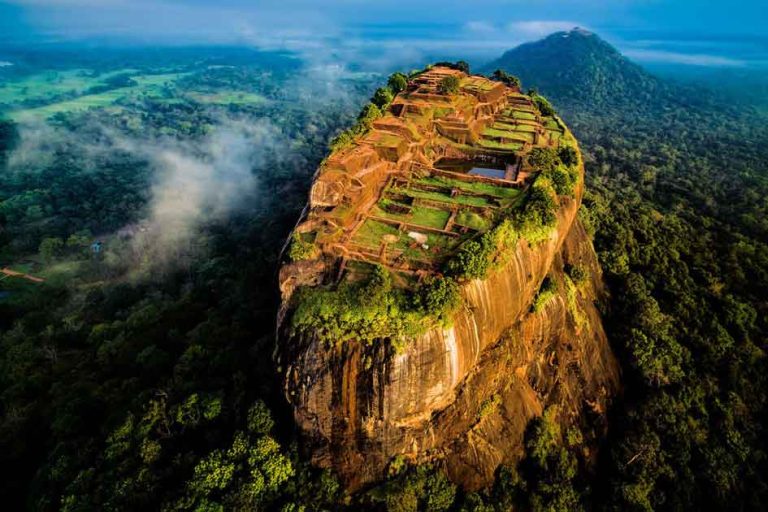Sigiriya
Sigiriya, also known as the Lion Rock, stands as a magnificent testament to Sri Lanka’s rich cultural heritage and architectural marvels. Situated in the heart of the island nation, Sigiriya rises dramatically from the surrounding plains, its sheer rock face dominating the landscape. This UNESCO World Heritage Site has captured the imagination of travellers and historians alike for centuries, drawing visitors from across the globe to marvel at its beauty and unravel its mysteries.
The history of Sigiriya dates back over two millennia, to the time of King Kasyapa I, who ruled the island from 477 to 495 AD. Seeking to establish a stronghold that would both symbolize his power and protect him from enemies, King Kasyapa chose the towering rock of Sigiriya as the site for his royal palace and fortress. The ambitious project took years to complete, with skilled artisans and laborers transforming the rock into a fortified citadel adorned with intricate frescoes, lush gardens, and elaborate water features.
One of the most iconic features of Sigiriya is the grand staircase leading to the summit, flanked by the remnants of colossal lion paws that once formed the entrance to the palace complex. As visitors ascend the stairway, they are treated to breathtaking views of the surrounding countryside, with lush forests and tranquil lakes stretching as far as the eye can see. At the top of the rock, the ruins of King Kasyapa’s palace offer a glimpse into the opulent lifestyle of the ancient rulers, with remnants of the royal chambers, audience halls, and even a swimming pool carved into the rock.
Attractions
- The Lion Rock: At the heart of Sigiriya stands the imposing Lion Rock, a massive monolithic rock formation rising abruptly from the surrounding plains. The rock gets its name from the gigantic lion paws that once adorned the entrance to King Kasyapa’s palace at the summit. While the lion’s head has long since crumbled away, the ascent to the top of the rock via a series of staircases is still an awe-inspiring experience
- Ancient Rock Fortress: Perched atop the summit of Sigiriya is the ancient rock fortress built by King Kasyapa I in the 5th century AD. The fortress complex includes remnants of the royal palace, audience halls, gardens, and water features. Exploring the ruins offers a fascinating glimpse into the opulent lifestyle of the ancient rulers of Sri Lanka.
- Sigiriya Frescoes: Halfway up the rock, visitors encounter a sheltered rock gallery adorned with exquisite frescoes. These vibrant paintings, known as the Sigiriya Frescoes, depict celestial maidens known as “apsaras” and are celebrated for their beauty, grace, and remarkable preservation. The frescoes provide a fascinating insight into the artistic and cultural achievements of ancient Sri Lanka.
- Lush Gardens: Surrounding the base of Sigiriya are the remnants of the lush gardens that once adorned the palace complex. These meticulously landscaped gardens featured elaborate water features, terraced gardens, and exotic flora, creating a verdant oasis in the heart of the Sri Lankan jungle.
- Water Gardens: The water gardens of Sigiriya are a marvel of ancient engineering, with
intricate irrigation systems that supplied water to the palace complex. Visitors can explore the network of fountains, pools, and canals that once flowed with water, marvelling at the ingenuity of the ancient builders.
- Panoramic Views: As visitors ascend the rock, they are treated to breathtaking panoramic.
views of the surrounding countryside. From the summit, one can see lush forests, tranquil lakes, and distant mountains stretching as far as the eye can see, offering a truly unforgettable vista.
- Wildlife Encounters: The surrounding area of Sigiriya is teeming with wildlife, including monkeys, birds, and even elusive leopards. Nature lovers can explore the nearby national parks and nature reserves, where they may encounter a diverse array of flora and fauna endemic to Sri Lanka.

